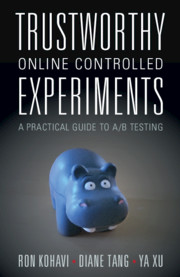Book contents
- Trustworthy Online Controlled Experiments
- Reviews
- Trustworthy Online Controlled Experiments
- Copyright page
- Contents
- Preface
- Acknowledgments
- Part I Introductory Topics for Everyone
- 1 Introduction and Motivation
- 2 Running and Analyzing Experiments
- 3 Twyman’s Law and Experimentation Trustworthiness
- 4 Experimentation Platform and Culture
- Part II Selected Topics for Everyone
- Part III Complementary and Alternative Techniques to Controlled Experiments
- Part IV Advanced Topics for Building an Experimentation Platform
- Part V Advanced Topics for Analyzing Experiments
- References
- Index
1 - Introduction and Motivation
from Part I - Introductory Topics for Everyone
Published online by Cambridge University Press: 13 March 2020
- Trustworthy Online Controlled Experiments
- Reviews
- Trustworthy Online Controlled Experiments
- Copyright page
- Contents
- Preface
- Acknowledgments
- Part I Introductory Topics for Everyone
- 1 Introduction and Motivation
- 2 Running and Analyzing Experiments
- 3 Twyman’s Law and Experimentation Trustworthiness
- 4 Experimentation Platform and Culture
- Part II Selected Topics for Everyone
- Part III Complementary and Alternative Techniques to Controlled Experiments
- Part IV Advanced Topics for Building an Experimentation Platform
- Part V Advanced Topics for Analyzing Experiments
- References
- Index
Summary
In 2012, an employee working on Bing, Microsoft’s search engine, suggested changing how ad headlines display (Kohavi and Thomke 2017). The idea was to lengthen the title line of ads by combining it with the text from the first line below the title, as shown in Figure 1.1.
Information
- Type
- Chapter
- Information
- Trustworthy Online Controlled ExperimentsA Practical Guide to A/B Testing, pp. 3 - 25Publisher: Cambridge University PressPrint publication year: 2020
